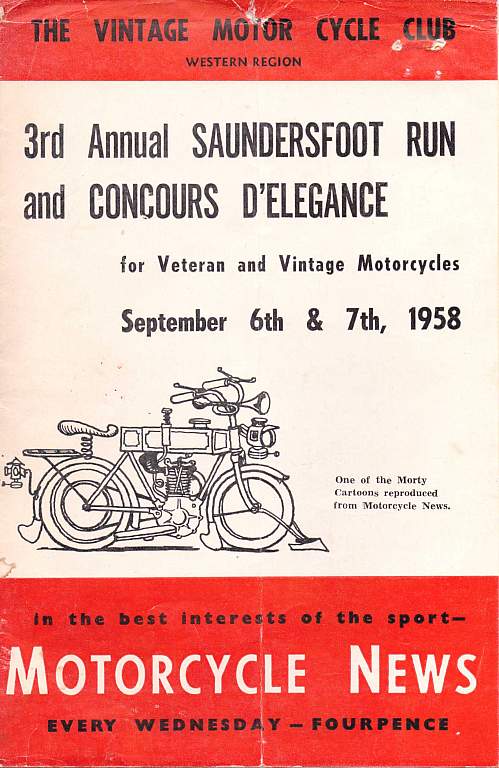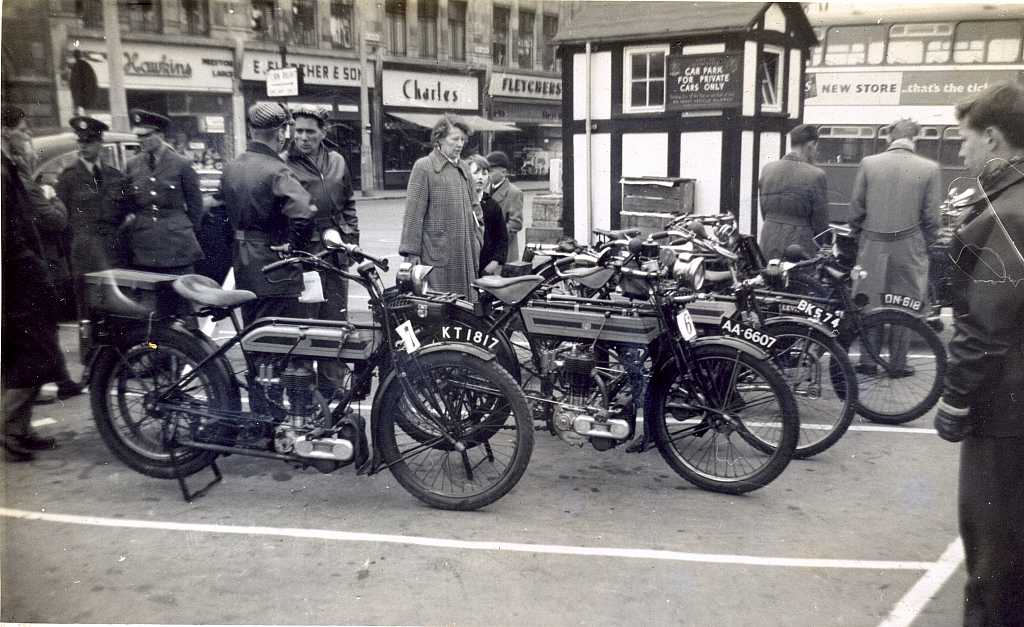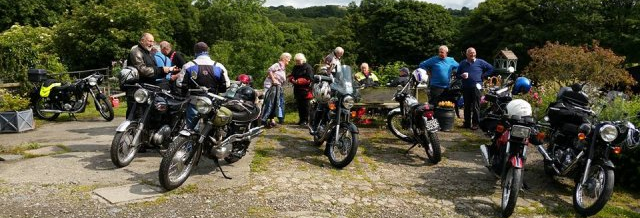Origins
The Saundersfoot weekend was first held in 1956 by the Cotswolds Section of the VMCC. The event consisted of a ride from Gloucester to Saundersfoot on the Saturday. After an overnight stay the Sunday run consisted of the ride home. Various historical reports and anecdotes can be found on the following History pages.
Saundersfoot Run - Inception and Early History
Below is the front cover of the 1958 programme .

The rest of the Saundersfoot 1958 programme can be viewed "HERE"
Thanks to Graham Beasley we are able to view the first Saundersfoot programme. Officially this is the programme for the second Saundersfoot run, but the first run didn't have a programme, so this is the first programme. "CLICK HERE"
Thanks to David Longbottom who now lives in Sydney Australia, we have a copy of the 1972 Saundersfoot Route Card and Entrants List.
Who now remembers motorcycling in the 1950s?. Bikes, a British vertical twin if you were lucky, a pre-war two-stroke or sv 250 if you were on a budget. The riding gear, flat caps, ex-army DR coats and boots, ex-RAF goggles. Petrol was four and nine a gallon. The roads were largely untouched from the 1920s & 1930s although cats' eyes and white lines were pretty new inventions. The motorway network was a pipedream. But stick your L plates on your Bantam or M20 at 16 years old are you were a motorcyclist.
Well, this distant time saw the growth of the Vintage movement mainly among people whose pleasure was derived from the discovery of some relic of an even earlier age of motorcycling.Not one of those quasi-modern 1930s machines - they were just everyday transport.Mounts were survivors of the first war or the 1920s, belt drivers and flat tankers found in sheds or barns, tidied up a little and coaxed into life once again on the still leisurely roads and lanes of the 1950s.
This scene was the background to the beginnings of the Saundersfoot Run. An emerging Vintage interest, the measured 'tock tock' of the Model H Triumph, primitive riding gear and uncluttered roads. Enthusiasts from the Cotswolds had forged links with West Wales and with the Saundersfoot Motorcycle Club in particular and, when a weekend event was proposed, keen support for a ride down to the Saundersfoot/Tenby area soon emerged. Peter Moffat and Arthur Mortimer used to recall early events when machine reliability was questionable to say the least and riders were followed by 'Scuderia Teuf Teuf', a support organisation consisting of an elderly lorry loaded with spare machines.
The start of it all was in 1956. Early participants included Peter Moffat, Felix Burke from Cheltenham (Felix claimed to have ridden in every Saundersfoot until his death 20 years ago), the late Evan John Williams was early on the scene also and Doug Bailey set a record of over 50 years for continuous participation in the event.
Following the success of the 1956 run, with great enthusiasm 1957 saw the Cotswold section gathering together an impressive collection of trophies and organising a proper competition. Many of those trophies are still competed for today, one of the most notable being the Jack Lewis 'Founders Cup' for the best time-keeping by the rider of any class of machine. The event soon became a by-word for 'a good weekend'. Riders were accommodated in B&Bs all round Saundersfoot with late and very informal get-togethers in local pubs. 'How were your digs old chap' was a common Sunday morning greeting. 'Dunno!, couldn’t find the bed, couldn’t eat the breakfast' was one noted reply.
Gradually the event format crystallised. Riders met at Gloucester early on the Saturday morning and set off. Hardy West Walian's got up at 4am to ride up to Gloucester. Some slept on floors or sofas in Cheltenham, Tim Rhys-Roberts described sleeping in an open side-car and waking up in all sorts of extreme discomfort.
St. Michael's Square Gloucester. Getting ready to start.
The Cotswolds Section passed on the organisation of the Saundersfoot run in 1962 to the South Wales Section. They formed a committee to run the 1962 event with Norman Stark as the Secretary of the meeting, Bill Phelps organised the events from 1963 to 1966 and again in 1969. In 1967 Terry Hopes was the Secretary of the meeting and during 1968 it was Joe O'Reilly. For the '67 and '68 events it was Bill Phelps’ role to visit and make all the arrangements at the Saundersfoot end.
The 1967 event incorporated the 3rd Windmill Rally, organised by England, who were the previous winners, with Arthur Mortimer acting as secretary for the event. The WIndmill Trophy was won by Wales, with the team consisting of:
Pat Cravos - 1924 Douglas 350cc
Graham Gardiner - 1925 2 speed Scott 600cc
Phil Griffiths - 1925 Sunbeam 500cc
Bryn Boulter - 1928 Norton 16h and sidecar
Colin Chambers - 1936 Scott 600cc
Robert Perring - 1941 Harley Davidson 750cc
The rules of the Windmill were that the winning country had to stage the following event - somehow, Wales managed to get out of doing that.
During 1970, Bill & Jean Phelps attended one of the WSW section meetings in the Castle Hotel, Carmarthen and officially handed over the organisation of the event and all the paperwork that came with it to Evan John Williams of the West South Wales Section.
Post 1970 and the riders met at Llandovery, most still having ridden from Gloucester, for a Saturday lunch and afternoon time trial. After a tentative timed route straight down the main road in 1970 the organisers soon realised that better routes existed.
Thus started a love affair between the event and the sleepy villages of the Cothi valley, Llansawel, Abergorlech and Brechfa.The opening up of roads round Llyn Brianne in the mid 1970s gave even more ambitious routes.The first time Llyn Brianne was visited, roads at the head of the reservoir were still unsurfaced, but the organisers were undeterred and Capel Soar, Tregaron, Llandewi Brefi and Newcastle Emlyn became familiar to riders from many parts of the UK and abroad.
The 21st and 25th events saw some really long routes. Llandrindod, home to many major pre-war events is a very motorcycle friendly place and for some years a start early on Saturday was made there, the route taking in the Elan valley, Cwmystwyth, Tregaron and Llyn Brianne before lunch! The secretary, commenting on a disturbed Friday night in a Llandrindod hotel in his Saturday speech prompted ribald reminiscences from Felix Burke of other 'Non-motorcycling' Llandrindod activities!
By now the event had adopted the Park House Hotel near Saundersfoot, and had been adopted by the Parker family, having linked up with Tom Parker in the Gower Hotel in the late 1960s. Prices of hotel accommodation had to rise a little over the years however, dinner bed and breakfast cost £3 in 1972.
Fewer changes have been made in more recent years, the continued support for the event reminding the organisers of the old adage that 'if it ain’t broke don’t fix it'.The event entry list has fluctuated a little, peaking at about 130 when we were able to combine it, for the 2nd time, with the 'Windmill' international rally in 1983 and dipping a little when changes to the Irish calendar meant that riders could no longer limber up at Saundersfoot, then catch the ferry to Ireland and repeat the experience for most of the following week.
Of course, one year we managed to clash with the Beaulieu Auto Jumble and the entries suffered, but that mistake was only made once. A really wet and windy event one year prompted the comment 'next year can we please have vertical rain'. The Saundersfoot over the years has seen many international riders. Jack and Erica Branse from Holland had a wonderful library and Jack was a mine of information. As the evening went on Erica would say 'Now we will have a sitting down party' and a large group would sit on the floor chatting in a mixture of Dutch and English. Talking of foreign cultures, Jurgen Neilson's hip flask was a potent weapon, one swig and you were ready for anything. 'Veeks, you must have another for the other leg', he told the secretary.
Routes and Route Cards
'Muddled directions may ruin a journey' was the secretary's horoscope the night before one Saundersfoot. The event organisers, long ago, realised that the aim of a good route card is to get all riders safely to the end of an event. This avoids the organisers having opprobrious comments heaped upon them (my dictionary say this means, reproachful, shameful, abusive – so its the right word). So route cards always include clues like 'at Llandampny L (Left) onto B4321 or SO (Straight On) to Cwmrhydyceirw'. Now, we have known riders who were convinced that Welsh place names were nothing but a snare to mislead the English – what nonsense! One year the organiser thoughtfully put hyphens in the longer place-names, only to be asked if Pont-rhyd-y-groes was the same place as Pontrhydygroes, difficult to win isn’t it? One midlands rider explained his system thus – "I think of an English word that the Welsh one reminds me of". Later when he returned, having been missing for about three hours, he explained that he had been following signs to Gollywog. "Anyone, he was told sternly, who goes up there looking for Gollywog deserves to find Gollywog". Vague instructions are sometimes unavoidable, if a junction is absolutely featureless. "left at rusty barn" prompted the discovery of innumerable rusty barns!. "Right near old shed" caused much confusion until the owner of a large bonfire was asked what he was burning. "Left at seven barred gate" produced an absolute census of gates but only one had 7 bars!
Fortunately the rash of sign post painting in West Wales seems to have died down though. In an early event, Evan and Dick asked a local what had become of a necessary sign post, only to be told with admirable frankness that "The Government in Westminster do put it up and we do take it down". Marshalls can show similar quirks of character. A favourite marshal (now unfortunately retired) was an old Monte Carlo rally driver. His cards were meticulously filled in, clearly written and every competitor accounted for. Marshals who are brought out of the pub by the sound of the first few machines whizzing past are less popular with organisers as are those who can’t tell the time (less of a problem now with digital clocks). One marshal once explained that he had dropped his clock, the hands had moved and would the clerk deduct 7 minutes from all competitors after 3:10 pm, just what the clerk of the course needs, though at least he was told what had happened and not left to work it out for himself.
The inclusion of the odd ford has always given pleasure to the organisers if not to the competitors. Most fords have been pretty innocuous, though occasional lessons in how to tackle them on two wheels have been learnt. For instance the water might be slightly deeper where the car wheels go through, but you are less likely to be brought off by a stray boulder than if you go straight through the middle. A little ford near Llandeilo taught one or two that lesson one year. The best incident (or worst, depending on your point of view as a sadistic organiser or as a rider) occurred in West Wales near Llandewi where an innocent looking ford (about three inches deep each time the organisers went through) proved to be downstream of Llys-y-fran, a large reservoir. The day of the event the water board decided to flush the sluices or some such technicality and the ford was transformed into an 18 inch raging torrent. Once again the secretary was assumed to have arranged it on purpose but “damp start” shares leapt on the stock exchange.
In 1966 - a Triumph still claimed to be on its original 1925 tyres – though later on another rider claimed to have the original air in his tyres.1962 – a well known lady rider had a terrible run on an Enfield and ended up having to ride pillion with another rider back to Bristol. A bungee strap broke whilst she was on the pillion, giving her such a whack on the bottom that both riders nearly fell off. She was glad of a car seat from Aust for the rest of the trip. Disagreement amongst motorcyclists are very rare, in public at least, but one year a fight started on a Saundersfoot night between members of the band. They were not asked back!
Another well known lady rider was very interested in the functions of all the flaps, pockets and zips of Dirk Hurtemann's elegant blue flying suit.
Spelling mistakes, accidental and deliberate puns have all featured in the programme over the years. Roy Dean appeared as Roy Lean one year. Those who knew Roy in his prime would appreciate the irony of the one. A Norton Velocette hybrid drew a comment that it was on song (Ivor Norvello, get it?).
The travellers award, for the entrant riding the furthest to take part in the event has had many worthy claimants, but it was John Stockwell a brilliant cartoonist and former Section Secretary who was quick to point out any injustices with cartoons of Bill Newtonski and Huw Adamsovitch featuring their choice of riding gear.
Anyone who has read this far will deserve some sort of endurance medal. But the reason for these recollections is to try to convey some of the sheer fun had at this event over the years by riders and organisers alike. So here’s to the next 60 years of 'doing the Saundersfoot'.

